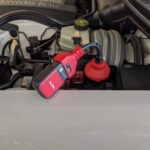The OBDII error code P0122 indicates a problem with the Throttle Position Sensor (TPS). Specifically, it means the Powertrain Control Module (PCM) has detected a voltage reading from the TPS circuit A that’s lower than the expected range. This article will delve into the causes, symptoms, and potential solutions for this common error code.
Understanding the Throttle Position Sensor (TPS)
The TPS is a crucial component in your vehicle’s engine management system. It’s a potentiometer that measures the angle of the throttle plate. As you press the accelerator pedal, the throttle plate opens, allowing more air into the engine. The TPS converts this mechanical movement into a voltage signal, which is sent to the PCM. The PCM uses this information to calculate the correct amount of fuel to inject and adjust the ignition timing for optimal engine performance. A voltage signal below the expected range suggests a problem within the TPS circuit.
Causes of the P0122 Code
Several issues can trigger the P0122 error code. Here are some of the most common culprits:
- Faulty TPS: The TPS itself might be worn out or damaged, causing inaccurate voltage readings. Internal damage or wear can lead to inconsistent signals, triggering the P0122 code.
- Wiring Issues: Damaged, corroded, or loose wiring in the TPS circuit can disrupt the voltage signal. This can include broken wires, loose connectors, or damaged insulation.
- Poor Connection: A poor connection between the TPS and its connector can also lead to a low voltage signal. This can be due to dirt, corrosion, or a damaged connector.
- Carbon Buildup: In some cases, carbon buildup on the throttle plate or body can interfere with the TPS operation.
Symptoms of a P0122 Code
While the illuminated check engine light is the most obvious sign, other symptoms might accompany a P0122 code:
- Poor Acceleration: The engine might hesitate or respond sluggishly when you press the accelerator.
- Rough Idle: The engine might run rough or stall at idle.
- Hard Starting: The engine might be difficult to start.
- Reduced Fuel Economy: You might notice a decrease in your vehicle’s fuel efficiency.
- Transmission Issues (Automatic): The transmission might shift erratically or refuse to shift properly.
- Limp Mode: In some cases, the vehicle might enter “limp mode” to prevent further damage, limiting engine power and speed.
Diagnosing and Fixing the P0122 Code
Addressing the P0122 code requires a systematic approach:
- Inspect Wiring and Connections: Carefully examine the wiring and connectors in the TPS circuit for any signs of damage, corrosion, or looseness. Repair or replace any faulty components.
- Test TPS Voltage: Use a multimeter to check the voltage output of the TPS. Compare the readings with the manufacturer’s specifications. A significantly low voltage confirms a problem with the TPS or its circuit.
- Clean the Throttle Body: Remove the throttle body and clean any carbon buildup. This can sometimes resolve the issue if the buildup is interfering with the TPS.
- Replace the TPS: If the TPS is faulty, replacement is usually the necessary solution. After replacing the TPS, it might require adjustment or calibration according to the manufacturer’s instructions.
Conclusion
The OBDII error code P0122 signifies a problem with the Throttle Position Sensor circuit, potentially affecting your vehicle’s performance, drivability, and fuel economy. By understanding the causes, symptoms, and diagnostic procedures, you can effectively address this issue and restore your vehicle to optimal running condition. If you’re unsure about performing these checks yourself, consulting a qualified mechanic is always recommended.

